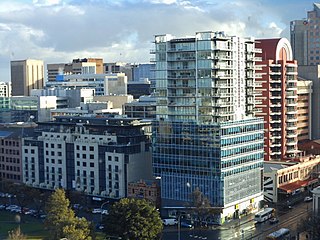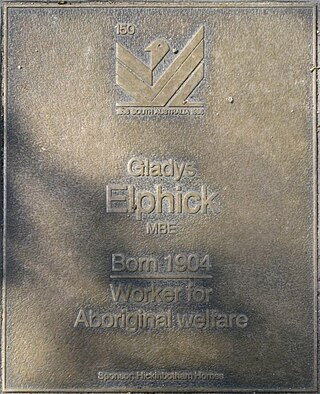The Kaurna people are a group of Aboriginal people whose traditional lands include the Adelaide Plains of South Australia. They were known as the Adelaide tribe by the early settlers. Kaurna culture and language were almost completely destroyed within a few decades of the British colonisation of South Australia in 1836. However, extensive documentation by early missionaries and other researchers has enabled a modern revival of both language and culture. The phrase Kaurna meyunna means "Kaurna people".

Victoria Square, also known as Tarntanyangga, is the central square of five public squares in the Adelaide city centre, South Australia.

This article details the history of Adelaide from the first human activity in the region to the 20th century. Adelaide is a planned city founded in 1836 and the capital of South Australia.

The Adelaide Park Lands comprise the figure-eight configuration of land, spanning both banks of the River Torrens between Hackney and Thebarton, which encloses and separates the City of Adelaide area from the surrounding suburbia of greater metropolitan Adelaide, the capital city of South Australia. They were laid out by Colonel William Light in his design for the city, and originally consisted of 2,300 acres (930 ha) "exclusive of 32 acres (13 ha) for a public cemetery". One copy of Light's plan shows areas for a cemetery and a Post and Telegraph Store on West Terrace, a small Government Domain and Barracks on the central part of North Terrace, a hospital on East Terrace, a Botanical Garden on the River Torrens west of North Adelaide, and a school and a storehouse south-west of North Adelaide.
Nunga is a term of self-identification for Aboriginal Australians, originally used by Aboriginal people in the southern settled areas of South Australia, and now used throughout Adelaide and surrounding towns. It is used by contrast with Gunya, which refers to non-Aboriginal persons. The use of "Nunga" by non-Aboriginal people is not always regarded as appropriate.
Kaurna is a Pama-Nyungan language historically spoken by the Kaurna peoples of the Adelaide Plains of South Australia. The Kaurna peoples are made up of various tribal clan groups, each with their own parnkarra district of land and local dialect. These dialects were historically spoken in the area bounded by Crystal Brook and Clare in the north, Cape Jervis in the south, and just over the Mount Lofty Ranges. Kaurna ceased to be spoken on an everyday basis in the 19th century and the last known native speaker, Ivaritji, died in 1929. Language revival efforts began in the 1980s, with the language now frequently used for ceremonial purposes, such as dual naming and welcome to country ceremonies.

Tjilbruke is an important creation ancestor for the Kaurna people of the Adelaide plains in the Australian state of South Australia. Tjilbruke was a Kaurna man, who appeared in Kaurna Dreaming dating back about 11,000 years. The Tjilbruke Dreaming Track or Tjilbruke Dreaming Trail is a major Dreaming trail, which connects sites from within metropolitan Adelaide southwards as far as Cape Jervis, some of which are Aboriginal sacred sites of great significance.

Montefiore Hill is a small hill in North Adelaide, South Australia, which affords a view over the Adelaide city centre.

Light Square, also known as Wauwi, is one of five public squares in the Adelaide city centre. Located in the centre of the north-western quarter of the Adelaide city centre, its southern boundary is Waymouth Street, while Currie Street crosses its northern tip, isolating about a quarter of its land. Morphett Street runs through the centre in a north–south direction.

Rymill Park / Murlawirrapurka, and numbered as Park 14, is a recreation park located in the East Park Lands of the South Australian capital of Adelaide. There is an artificial lake with rowboats for hire, a café, children's playground and rose garden, and the Adelaide Bowling Club is on the Dequetteville Terrace side. The O-Bahn passes underneath it, to emerge at the western side opposite Grenfell Street.

Hindmarsh Square/Mukata is one of five public squares in the Adelaide city centre, South Australia. It is located in the centre of the north-eastern quarter of the city, and surrounds the intersection of Grenfell and Pulteney streets, near the eastern end of the Rundle Mall. Pirie Street forms the southern boundary of the square.

Adelaide city centre is the inner city locality of Greater Adelaide, the capital city of South Australia. It is known by locals simply as "the City" or "Town" to distinguish it from Greater Adelaide and from the City of Adelaide local government area. The population was 15,115 in the 2016 census.

Whitmore Square, also known as Iparrityi, is one of five public squares in the Adelaide city centre, South Australia. Occupying 2.4ha, it is located at the junction of Sturt and Morphett streets in the south-western quarter of the Adelaide city grid.

Hurtle Square, also known as Tangkaira, is one of five public squares in the Adelaide city centre, South Australia. Located in the centre of the south-eastern quarter of the city, it surrounds the intersection of Halifax and Pulteney streets. Its north edge is bounded by Carrington Street.
Morphett Street is a main street in the west of the city centre of Adelaide, South Australia, parallel to King William Street and numbered from north to south. At its northern end it is part of the West End of Adelaide, a thriving cultural and entertainment precinct, with the Lion Arts Centre on the south-western corner of its junction with North Terrace.
Rundle Park / Kadlitpina, also known as Park 13, is a part of the Adelaide Park Lands in Adelaide, South Australia. It was known as Rundle Park until its Kaurna name was assigned as part of the dual naming initiative by Adelaide City Council in 2003. The park is bounded by East Terrace, Botanic Road (north), Dequetteville Terrace (east) and Rundle Road (south).
Point Pearce, also spelt Point Pierce in the past, is a town in the Australian state of South Australia. The town is located in the Yorke Peninsula Council local government area, 194 kilometres (121 mi) north-west of the state capital, Adelaide.

Gladys Elphick, also known as Auntie Glad, was an Australian Aboriginal woman of Kaurna and Ngadjuri descent, best known as the founding president of the Council of Aboriginal Women of South Australia, which became the Aboriginal Council of South Australia in 1973.

Ivaritji also known as Amelia Taylor and Amelia Savage, was an elder of the Kaurna tribe of Aboriginal Australians from the Adelaide Plains in South Australia. She was "almost certainly the last person of full Kaurna ancestry", and the last known speaker of the Kaurna language before its revival in the 1990s.
Kudnarto, also known as Mary Ann Adams, was an Aboriginal Australian woman of the Kaurna and Ngadjuri peoples who lived in the colony of South Australia. She is notable for being the first Aboriginal woman to legally marry a colonist in South Australia, making legal history in 1848, and for having many notable descendants.














